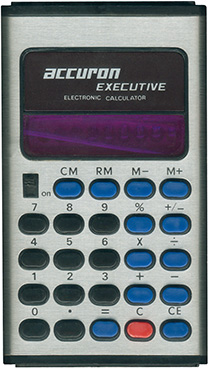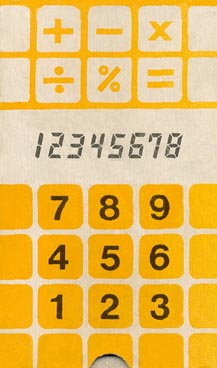
In the 1970s, electronic calculators became widely available and affordable for the average consumer. Companies competed to make their calculators stand out with innovative designs and features. One such calculator was the Accuron Executive, a stylish model aimed at the “handbag market.”
The Accuron Executive was a compact, lightweight calculator measuring about 2.7 x 4.5 x 0.9 inches and weighing just 2.7 ounces without batteries. It ran on a single 9V battery or an AC adapter. The sleek black plastic case had an aluminum front panel and ridged top and bottom panels, giving it a clean, futuristic look. The silver logo and model name stood out on the dark background.

The main feature was the eight-digit red LED display, which had a purple filter for good visibility. However, the bubble lens limited the viewing angle. Below the display were the calculator’s keys. These were “squishy and springy,” but prone to bounce.
The Accuron Executive had the basic functions expected of a mid-1970s calculator. It could add, subtract, multiply, and divide. It also had a percent key, sign change key, and four-function memory. The memory was not indicated, so the user had to remember if a number was stored.
Despite the nice appearance, the calculator had some limitations. Negative numbers were shown with a minus sign in the leftmost digit, limiting them to only seven digits. Inputting more than eight digits resulted in an error. Overflow also caused errors, but these could be cleared with the “CE” (clear entry) key.

Inside, the calculator was very simple, with just a single Texas Instruments TMS0972 chip and the LED display. It had no other components on the circuit board. The keyboard attached separately with wires.
The Accuron Executive likely appeared under other brand names as well. It was a version of the Universal Executive, a rebranded calculator sold by various companies. The stylish design and purple filter aimed to appeal to women buyers. For the era, the Accuron Executive was a reasonably functional calculator with some flair, though not without drawbacks. It exemplified how manufacturers differentiated basic 1970s electronics through creative industrial design.